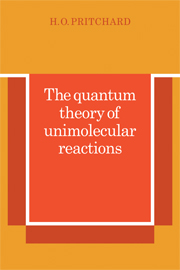Book contents
- Frontmatter
- Contents
- Preface
- Acknowledgements
- 1 The observed properties of thermal unimolecular reactions
- 2 The master equation for internal relaxation in molecules
- 3 Reaction as a perturbation of the internal relaxation
- 4 The specific rate function k(E) as an inverse Laplace transform
- 5 Unimolecular fall-off in strong collision systems
- 6 A molecular dynamic approach to specific rate functions
- 7 Building in the randomisation processes
- 8 Weak collision processes
- 9 How well does it all work?
- Appendix 1 Units, symbols, and errata
- Appendix 2 Rate constants for the thermal isomerisation of cyclopropane and for the thermal decomposition of cyclobutane
- Appendix 3 Computer programs for thermal unimolecular reactions
- Exercises
- References
- Author index
- Subject index
Appendix 3 - Computer programs for thermal unimolecular reactions
Published online by Cambridge University Press: 04 August 2010
- Frontmatter
- Contents
- Preface
- Acknowledgements
- 1 The observed properties of thermal unimolecular reactions
- 2 The master equation for internal relaxation in molecules
- 3 Reaction as a perturbation of the internal relaxation
- 4 The specific rate function k(E) as an inverse Laplace transform
- 5 Unimolecular fall-off in strong collision systems
- 6 A molecular dynamic approach to specific rate functions
- 7 Building in the randomisation processes
- 8 Weak collision processes
- 9 How well does it all work?
- Appendix 1 Units, symbols, and errata
- Appendix 2 Rate constants for the thermal isomerisation of cyclopropane and for the thermal decomposition of cyclobutane
- Appendix 3 Computer programs for thermal unimolecular reactions
- Exercises
- References
- Author index
- Subject index
Summary
This appendix provides a set of self-contained computer programs for the calculation of rate constants in thermal unimolecular systems. Most of them were written by Andrew Yau [78.Y2], and have now stood up to five years, or so, of continual use. They may run into trouble occasionally if anharmonicity values in the range 0.005–0.006 are used for several oscillators at the same time, or if other unusual molecular parameters are tried but, by and large, they perform acceptably in normal circumstances. Some effort has been expended in trying to make the repetitive segments of the calculations efficient, but there is no pretence at elegance – a contradiction in terms when one is constrained to use FORTRAN [72.D3].
The organisation of the routines is as follows. The MAIN routine handles the flow of the calculation and the assembly of the input parameters. Then there is a UTILITY package which calculates the required sums and densities of states with appropriate precision; this is sufficiently efficient that it is no longer necessary to group the molecular frequencies in most cases. It also divides the reactive energy range into grains of the specified size, computes the equilibrium grain populations βr, and their respective specific rate constants dr = k(E) by the inverse Laplace transform method, equation (4.9). Finally, UNIRAT calculates the rate constant at the requested values of the pressure.
- Type
- Chapter
- Information
- The Quantum Theory of Unimolecular Reactions , pp. 135 - 155Publisher: Cambridge University PressPrint publication year: 1984



